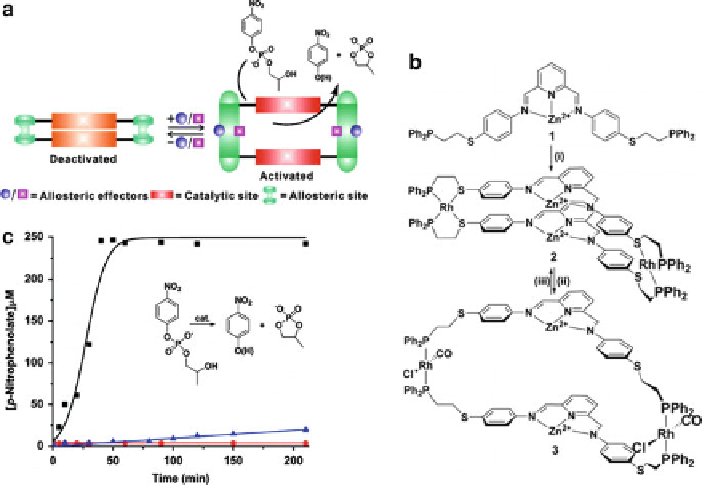Biomedical Engineering Reference
In-Depth Information
Fig. 5 (a) Supramolecular allosteric regulation via the WLA. (b) Synthesis of the supramolecular
allosteric catalyst 3. The AcO
counterions ligands and counterions for the complexes are omitted
for clarity. Reagents: (
i
) Rh(norbornadiene)
2
BF
4
;(
ii
)
n
-Bu
4
NCl/CO; (
iii
)N
2
bubbling or 2 equiv of
AgBF
4
.(c) Product (
p
-nitrophenolate) concentration versus time for 2 (
circle
) and 3 (
square
)
macrocyclic compounds. A control experiment with compound 1 (
triangle
) was carried out under
the same reaction conditions. Reactions were monitored by UV-vis spectroscopy. Adapted with
permission from [
29
]. Copyright 2007 American Chemical Society
Significantly, the WLA has been utilized to create structures that offer amplifi-
cation in chemical detection where the effector molecule is the analyte and the
catalytic reaction turned on by the effector generates a fluorescent surrogate
molecule that provides an indirect signal output associated with the recognition
event [
28
]. This completely synthetic system resembles the signal amplification
properties of ELISAs commonly used in biosensing for a wide range of analytes.
However, one drawback of this initial system was the small but measurable
background catalysis exhibited by the closed “off” state of the macrocycle. In the
context of sensor performance, higher background signal raises the lower limit of
analyte detection and is therefore undesirable.
Recently, Mirkin et al. overcame this background issue with a tetrametallic
macrocycle assembled via the WLA that operates as a completely reversible
allosteric catalyst for the bimolecular hydrolysis of 2-(hydroxypropyl)-
p
-nitrophenyl
phosphate (HPNP), a model substrate for RNA (Fig.
5a
)[
29
]. Figure
5b
shows the
strategy for preparing the “open” active allosteric catalyst 3 from the “closed”
condensed macrocycle 2 assembled from an equimolar ratio of hemilabile Zn(II)-
functionalized ligand 1 and a Rh(I) precursor. The formation of compound 2 was
characterized by
1
Hand
31
P NMR, ESI-MS, and single-crystal X-ray diffraction

Search WWH ::

Custom Search